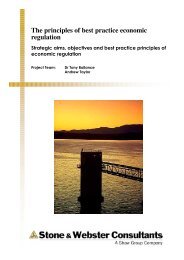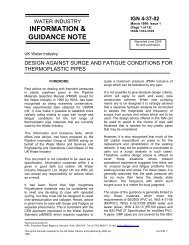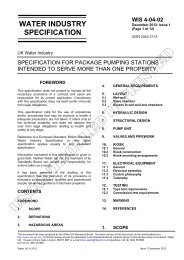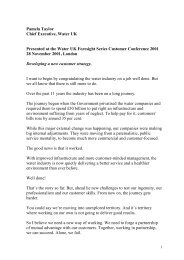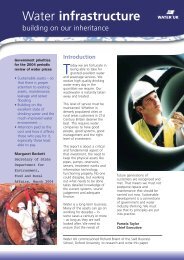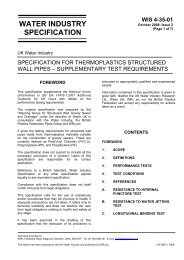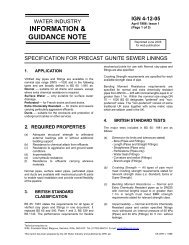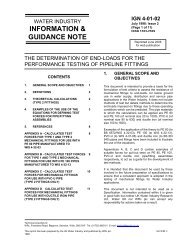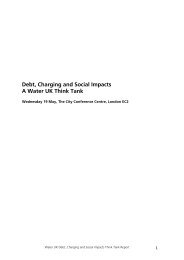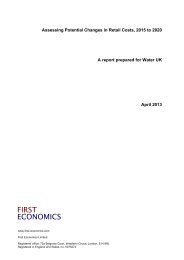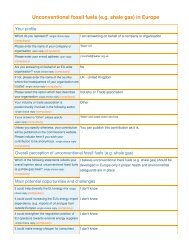Environmental, Economic and Social - Water UK
Environmental, Economic and Social - Water UK
Environmental, Economic and Social - Water UK
You also want an ePaper? Increase the reach of your titles
YUMPU automatically turns print PDFs into web optimized ePapers that Google loves.
<strong>Environmental</strong>, economic <strong>and</strong> social impacts of the use of sewage sludge on l<strong>and</strong> -Consultation Report on Options <strong>and</strong> Impacts<strong>Environmental</strong>, <strong>Economic</strong> <strong>and</strong> <strong>Social</strong> impacts of the use of SewageSludge on L<strong>and</strong>: Consultation Report on Options <strong>and</strong> ImpactsName of organisation consulting: European Commission’s DGEnvironment<strong>Water</strong> <strong>UK</strong> responseDate of submission: 13 January 2010Contents1. Introduction 22. Subjects not covered by questions in the consultation –Scientific evidence base on st<strong>and</strong>ards relating to• Organic Contaminants,• Potential Toxic Elements• Pathogens3-163. Responses to consultation questions 16-224. Other comments – Annexes 3 <strong>and</strong> 4, <strong>and</strong> References 22 – 321
<strong>Environmental</strong>, economic <strong>and</strong> social impacts of the use of sewage sludge on l<strong>and</strong> -Consultation Report on Options <strong>and</strong> Impacts1. Introduction1.1 <strong>Water</strong> <strong>UK</strong> welcomes the opportunity to respond to the EuropeanCommission’s “<strong>Environmental</strong>, economic <strong>and</strong> social impacts of the use ofsewage sludge on l<strong>and</strong> – Consultation Report on Options <strong>and</strong> Impacts”.1.2 <strong>Water</strong> <strong>UK</strong> represents water <strong>and</strong> waste water service providers at <strong>UK</strong><strong>and</strong> European level. Our members provide the <strong>UK</strong> with safe, clean water<strong>and</strong> contribute to the protection <strong>and</strong> enhancement of public health <strong>and</strong> theenvironment.1.3 We support the principle outlined in the Waste Thematic Strategic<strong>and</strong> the long term vision to make Europe a recycling society thatdecouples economic growth from increased waste generation. Wetherefore believe that the revised Sludge Directive must facilitate <strong>and</strong>continue to encourage recycling of treated sewage sludge (biosolids) foruse on l<strong>and</strong>.1.4 In particular we think the EC could be in breach of the WasteHierarchy provisions of Article 4 (1) of the Waste Framework Directive,if the revised Sludge Directive as a policy instrument encourages disposalinstead of practices higher in the waste hierarchy. We believe this is thecase because policy makers are required to “apply as a priority order inwaste prevention <strong>and</strong> management legislation <strong>and</strong> policy: preventions,preparing for re-use, recycling, other recovery (e.g. energy recovery) <strong>and</strong>disposal”. We therefore consider that some of the Options underconsideration in this consultation if adopted will be discouragingrecycling in favour of disposal (incineration <strong>and</strong> l<strong>and</strong>fill).1.5 We support <strong>and</strong> fully endorse the statement that “any revision shouldaim to retain the flexibility of the original Directive which has permittedsludge recycling to operate effectively across the wide range ofagricultural <strong>and</strong> other environmental conditions found within theexp<strong>and</strong>ed EU”.1.6 We believe, however, as a general overview <strong>and</strong> at a fundamentallevel, the consultation has missed a critical step in the overall reviewprocess in terms of developing a reasonable <strong>and</strong> rational set of technicallyjustified criteria that could provide the basis of a revised directive. Forinstance, adopting a technical basis to st<strong>and</strong>ards <strong>and</strong> controls on sludge isrecommended by WHO, to maximise opportunities for resource recoveryfrom recycling sludge, whilst at the same time ensuring that human health<strong>and</strong> the environment are protected (Chang et al., 2002). Discussion,2
<strong>Environmental</strong>, economic <strong>and</strong> social impacts of the use of sewage sludge on l<strong>and</strong> -Consultation Report on Options <strong>and</strong> Impactsconsultation <strong>and</strong> agreement on this is necessary before the environmental,economic <strong>and</strong> social impacts of a revision can be quantitativelyaddressed. We discuss some of the specific aspects later in our responsesto Options 2 <strong>and</strong> 3.1.7 Using the current Sludge Directive as a basis, the <strong>UK</strong> water industryhas developed further plans to increase renewable energy generated fromsewage sludge as a primary contribution to the climate change mitigation<strong>and</strong> the Renewable Energy Directive. We are keen to see that any revisionto the Sludge Directive continues to support this policy <strong>and</strong> enables theresidual sludge to be used are fertiliser <strong>and</strong> soil improver.2. Subjects not covered by the consultation2.1 As noted in paragraph 1.6 above we strongly consider that a key stephas been missed in the consultation process sets out on sound sciencebasis <strong>and</strong> justifies the st<strong>and</strong>ards proposed. It seems the proposed new <strong>and</strong>tightened st<strong>and</strong>ards have a collation of arbitrary st<strong>and</strong>ards against whichimpact assessments have been made. We think it will be improper for theDirective to be revised on the basis of these arbitrary st<strong>and</strong>ards, some ofwhich were set for political <strong>and</strong> local reasons. We provide detailedcomments on the st<strong>and</strong>ards for Organic Contaminants, Potentially ToxicElements (PTEs) <strong>and</strong> Pathogens for Options 2 <strong>and</strong> 3 as follows:2.2 Regarding the limit values for potentially toxic elements (PTEs) <strong>and</strong> organiccontaminants (OCs) specified in Option 2 <strong>and</strong> 3, these require a robust technicalbasis. The values have yet to be properly debated <strong>and</strong> discussed before their impactcan be assessed. An initial discussion took place in response to the proposalspresented in the 3 rd Draft Working Document on Sludge (CEC, 2000). However, thiswas severely criticised <strong>and</strong> was ultimately withdrawn because the regime of controlshad no technical basis <strong>and</strong> was simply selected from national regulations. A keyproblem with this approach is that controls adopted in one country may be applicablelocally, but they may not be appropriate in another country where different conditionsapply. This strategy therefore undermines a key aim of the revision <strong>and</strong> to maintainthe flexibility provided by the existing Directive. Thus, the overarching regime ofcontrols provided by the revised Directive will differ from those in individual MemberStates <strong>and</strong> should take full account of the international scientific research on theenvironmental effects of sewage sludge recycling to agricultural l<strong>and</strong> – which may notbe the case in specific countries, where local, political <strong>and</strong> perception issues mayhave a strong influence the decisions regarding national controls on the agriculturaluse of sludge.2.3 The options assessed in this report are based on criteria apparently mainly froma draft directive document from 2003 (CEC, 2003), that appears to largely reflect thelimit values <strong>and</strong> controls particularly for chemical contaminants from the originalWorking Document on Sludge (CEC, 2000), as well as the highly tentativerecommendations on pathogens from Carrington (2001). The CEC (2003) valueswere apparently selected to undertake the impact assessment in the absence of3
<strong>Environmental</strong>, economic <strong>and</strong> social impacts of the use of sewage sludge on l<strong>and</strong> -Consultation Report on Options <strong>and</strong> Impactsproposals for suitable limits from the first consultation exercise of the review.However, developing the regime of controls for the revised Directive is a non-trivialexercise. Consultees were not asked to provide a view on this, although opinionswere expressed, <strong>and</strong> it would be unreasonable to expect that this would provide thebasis for a strategic regime of controls for the revised Directive. This itself requires afull, technical assessment with detailed proposals for consultation. It is unclear whatthe status of CEC (2003) is as the document has not been ‘officially’ circulatedpreviously or proposed by the European Commission. However, this consultationreport also goes a stage further by proposing a further reduction in PTE limits underOption 3 compared to CEC (2003). A critical question therefore, is what is therationale <strong>and</strong> technical basis for the regime of controls evaluated under Options 2<strong>and</strong> 3? This should be explained so the basis to the proposed revision of theDirective is clear <strong>and</strong> transparent. A cursory assessment of the options examinedshows that they are generally illogical <strong>and</strong> arbitrary. Therefore this raises questionsover the relevance <strong>and</strong> validity of the fundamental assumptions to the impactanalysis. Specific details <strong>and</strong> issues relating to these problems are discussed below.Organic Contaminants2.4 There has been an increasing level of assessment <strong>and</strong> evaluation of OCs insludge <strong>and</strong> a framework for the risk assessment of OCs in sludge has beendeveloped (Schowanek et al., 2004), applying the principles laid down in theTechnical Guidance Document TGD) on Risk Assessment of Chemical Substancesfollowing European Regulations <strong>and</strong> Directives (EC, 2003). However, the increasinglevel of investigation <strong>and</strong> application of risk assessment techniques has consistentlyshown OCs in sludge amended soil have negligible impact on human health or theenvironment. This was the view expressed by the WHO Working Group on the Riskto Health of Chemicals in Sewage Sludge Applied to L<strong>and</strong> (Dean <strong>and</strong> Suess, 1985)<strong>and</strong> the COST 68/681 programme (Sauerbeck <strong>and</strong> Leschber, 1992) <strong>and</strong> is theopinion repeatedly expressed throughout the international scientific literature (Jacobset al., 1987; Schmitzer et al., 1988; Ar<strong>and</strong>a et al., 1989; Kampe <strong>and</strong> Leschber, 1989;O’Connor et al., 1991; Hembrock-Heger, 1992; Offenbacher, 1992; US EPA, 1992ab;Webber et al., 1994; Giol<strong>and</strong>o et al., 1995; NRC, 1996; Duarte-Davidson <strong>and</strong> Jones,1996; O’Connor, 1996; Balk <strong>and</strong> Ford, 1999ab; McGrath, 2000; Smith, 2000; WEAO,2001; Petersen et al., 2003; Topp et al., 2008; Reiss et al., 2009; Smith, 2009). Themost recent European risk assessment (Eriksen et al., 2009) is entirely consistentwith international opinion <strong>and</strong> concluded that the risk associated with the use ofsewage sludge as a soil conditioner to be of no significance for the dietary intake ofthe assessed contaminants, to the soil ecosystem, the aquatic environment or foodproducing animals. There is a clear consensus in the scientific literature on thisimportant issue demonstrating that limit values for OCs in sludge are unnecessary.Some further relevant examples will be briefly discussed to illustrate this.2.5 When the European risk assessment methodology for OC in sludge (Schowaneket al., 2004) was applied to the surfactant compound linear alkylbenzene sulphonate(LAS) (Jensen et al., 2007; Schowanek et al., 2007) the results showed that, evenmaximum concentrations of this compound found in sludge do not pose a risk to theenvironment. This analysis therefore superceded the earlier risk assessment byDanish scientists that formed the basis of the national st<strong>and</strong>ards on LAS that wereadopted in Denmark <strong>and</strong> that were incorporated into the 3 rd Draft Working Documenton Sludge (CEC, 2000). Over 30 % of European sludges would fail to meet the CEC(2000) limit of 2600 mg kg -1 DS of LAS. (Figure 1). However, the sludge qualityst<strong>and</strong>ard (SQS) for LAS in sludge derived by Schowanek et al. (2004) was 5 g kg -1DS, <strong>and</strong> this value has been proposed as the limit for LAS in CEC (2003). Only oncehas an LAS concentration in sludge (3 g kg -1 DS) above the SQS value beenrecorded. Thus, all European sludge can be used on l<strong>and</strong> with no risk to the4
<strong>Environmental</strong>, economic <strong>and</strong> social impacts of the use of sewage sludge on l<strong>and</strong> -Consultation Report on Options <strong>and</strong> Impactsenvironment from LAS <strong>and</strong> setting a European limit for LAS in the revised Directiveserves no purpose or environmental benefit what so ever (Figure 1). Furthermore,the fact that LAS is not an identified <strong>Water</strong> Framework Directive (WFD) PriorityHazardous Substance (PHS) further emphasises its minimal risk to the environment<strong>and</strong> that regulation in wastewater treatment residuals is unnecessary <strong>and</strong> would beinconsistent with the broader regulatory regime of the WFD.Figure 1. Distribution of LAS concentrations in digested sewage sludge in EuropeanMember States (Schowanek et al., 2004). The Sludge Quality St<strong>and</strong>ard for LAS is50000 mg kg -1 DS <strong>and</strong> the maximum LAS concentration recorded in sludge is 30000mg kg -1 DS, therefore all European sludge can be applied to l<strong>and</strong> with no impact onthe environment due to LAS. Since all sludges contain less LAS than the SQS thereis no requirement to regulate this substance in sludge for agricultural use.2.6 In contrast to LAS, nonylphenol (NP) is a WFD PHS since it is as an identifiedendocrine disrupting compound (EDC). Nonyl phenol <strong>and</strong> nonyl phenol ethoxylates(NPEOs) are also regulated under the Dangerous Substances Directive 2003/53/EC.Consequently there are controls <strong>and</strong> measures in place to restrict the use <strong>and</strong>emissions of NP/NPEs to the environment at source <strong>and</strong> this has markedly reducedthe concentrations of these substances in sewage sludge. For example, in 1989,digested sewage sludge samples collected at 2 <strong>UK</strong> WWTPs contained 250-820 mgkg DS -1 NP/NPEO whereas concentrations in a survey of <strong>UK</strong> sludge in 2009 were≤30 mg kg -1 DS <strong>and</strong> were typically ≤10 mg kg -1 DS. Therefore, the NP/NPE contentof contemporary sludges are typically more than 10 times less than the limit value of450 mg kg -1 DS proposed under Option 3. Furthermore, NP/NPEO degradation in soilis rapid (half-life 20 – 60 days for example) <strong>and</strong> enhanced by the addition of organicsubstrates such as biosolids <strong>and</strong> uptake of sludge-bourne NP/NPEOs by plants isvery low (Kirchmann <strong>and</strong> Tengsved, 1991; Roberts et al., 2006; Sjöström et al.,2008) so the possibility of transfer or risk to the human food chain in practice islimited. Given that NP/NPEOs are effectively controlled at source, the concentrationsin sludge are significantly below the proposed limit value, they degrade rapidly in soil<strong>and</strong> do not transfer to the human food chain, there is no technical argument tosupport their regulation in sludge for agricultural application. This was confirmed inthe recent risk assessment by Eriksen et al. (2009), which concluded that NPs, as5
<strong>Environmental</strong>, economic <strong>and</strong> social impacts of the use of sewage sludge on l<strong>and</strong> -Consultation Report on Options <strong>and</strong> Impactswell as octylphenols <strong>and</strong> LAS, were of low concern for the agricultural utilisation ofsewage sludge. Thus, including a limit value for NP/NPE in sludge has no benefit forhuman health or the environment. The 3 rd Draft Working Document on Sludge (CEC,2000) included a proposed limit for di(2-ethylhexyl)phthalate (DEHP) of 100 mg kg -1DS, but CEC (2003) did not propose a limit value for this compound. Nevertheless,DEHP is included in the list of chemicals as part of the more stringent regime ofst<strong>and</strong>ards evaluated although no limit is given in Table 3. However, a maximumconcentration of 100 mg kg -1 DS is indicated as appropriate in Section 3.3.2 <strong>and</strong>4.3.2 of the report describing the ‘<strong>Environmental</strong> impacts’ for Option 2 <strong>and</strong> 3. TheEnglish in this part of the report is ambiguous as it states that ‘when limits are not setat this level, there could be limited benefits in terms of reduced health risk’.Presumably the authors actually mean that there would be limited benefits if limitswere set at this level? However, this analysis <strong>and</strong> interpretation is completely wrong<strong>and</strong> a misinterpretation of the scientific evidence relating to the behaviour <strong>and</strong>environmental consequences of this compound. For a detailed discussion of theimplications of DEHP in sludge <strong>and</strong> amended agricultural soil see Smith (2009).DEHP <strong>and</strong> other phthalate acid esters are not environmentally persistent <strong>and</strong> arereadily degraded in soils <strong>and</strong> sewage sludge under both aerobic <strong>and</strong> anaerobicconditions (Keyser et al., 1976; Walker et al., 1984; Group, 1986; Staples et al.,1997). Experimental data show no uptake of DEHP by crops or impacts of thecompound on plant growth or the soil ecosystem (Kirchmann et al., 1991; Cartwrightet al., 2000; Jensen et al., 2001; Petersen et al., 2003). Therefore, DEHP does nottransfer to the human foodchain or impact sludge-amended soil (Eriksen et al.,2009). DEHP has been subject to review as a possible WFD PHS, however, theEuropean Union risk assessment concluded that there was no tangible risk to theenvironment or human health (EC, 2008); DEHP has therefore not been designatedas a PHS within the WFD. Therefore, it would seem to be entirely inconsistent toregulate DEHP in sludge for agricultural application, particularly when terrestrial riskassessment also concludes that, as with the other identified OCs in sludge, DEHPhas no impact on human health or the environment (Eriksen et al., 2009).Consequently, there is substantial evidence showing the minimal impact of thiscompound in sludge-amended soil <strong>and</strong> demonstrates unequivocally that regulation ofDEHP in sludge for agricultural utilisation is unnecessary <strong>and</strong> categorically wouldhave no health or environmental benefits.2.7 The concentrations of traditional persistent organic pollutants (POPs) in sludge,notably PCDD/Fs, PCBs <strong>and</strong> PAHs have declined significantly in response toeffective source controls imposed through European environmental legislation. Forexample, the PCDD/F concentration in sludge has declined <strong>and</strong> is well below the limitvalue suggested in Option 3 of 100 ng TEQ kg -1 DS in contemporary sludges (Figure2) (also see for example, Martínez et al., 2007). Also, research has shown that theconsequences of these substances in sludge <strong>and</strong> amended soil for human health arenegligible (eg US EPA, 1992ab; Webber et al., 1994; Wild <strong>and</strong> Jones, 1991; Wild etal., 1994; O’Connor, 1996; Duarte-Davidson <strong>and</strong> Jones, 1996; Jones <strong>and</strong> Northcott,2000; IC Consultants, 2001; Stevens et al., 2003; US EPA, 2003). Therefore, the ECJRC recommended that the routine monitoring of PCDD/Fs, PCBs <strong>and</strong> PAHs insludge used for agricultural purposes was unnecessary (Erhardt <strong>and</strong> Prüeβ, 2001).2.8 PCDD/F <strong>and</strong> PCB concentrations in <strong>UK</strong> sludge <strong>and</strong> measured in internationalsurveys are well below the limits proposed by CEC (2003), consequently there is nocase for including maximum permissible concentrations for these substances in arevision of Directive 86/278/EEC. The EU proposals are also that the ‘sum of thePAHs’ acenaphthene, phenanthrene, fluorene, fluoranthene, pyrene, benzo(b+j+k)fluoranthene, benzo(a)pyrene, benzo(ghi)perylene <strong>and</strong> indeno(1,2,3-cd)pyreneshould not exceed 6 mg kg -1 DS in sludge. However, it is not apparent why these6
<strong>Environmental</strong>, economic <strong>and</strong> social impacts of the use of sewage sludge on l<strong>and</strong> -Consultation Report on Options <strong>and</strong> Impactsparticular congeners have been selected from the array of PAHs present inenvironmental samples. Carefully performed pathways analyses also show thatsludge addition to l<strong>and</strong> is a minor source of PAHs <strong>and</strong> that there are no risks to thefoodchain at the loadings typically applied (Duarte-Davidson et al., 1995).Nevertheless, a significant proportion of European sludges would fail to comply withthe proposed limit of 6 mg kg -1 DS as the sum of 9 PAH congeners (Table 1). Forexample, in a survey of 14 sludge samples from different wastewater treatment plantin the <strong>UK</strong> (Jones <strong>and</strong> Northcott, 2000; Stevens et al., 2003), all the sludges containedlarger PAH concentrations (range:18 – 50 mg kg -1 DS ∑of EU 9 PAH congeners )than the proposed PAH limit value, irrespective of the type of catchment <strong>and</strong> relativeproportions of industrial <strong>and</strong> domestic effluent treated. Thus, typical sewage sludgesfrom every country <strong>and</strong> every survey are likely to be in exceedance of the proposedEU st<strong>and</strong>ard. It is therefore likely that implementation of this st<strong>and</strong>ard would result inthe cessation of a very substantial proportion of all sewage sludge applications toagricultural l<strong>and</strong> in the EU with no benefit for human health or the environment.Dioxin concentration (ng TEQ kg -1 DS)450400350300250200150100500US EPA proposedlimitEuropeanlimit1944 1949 1953 1956 1958 1960 1998YearFigure 2. Dioxin content of archived samples of sewage sludge from a majorwastewater treatment works in West London, <strong>UK</strong> (Note: following detailed riskassessment US EPA final decision was not to regulate dioxins in sludge – seeUSEPA (2003)) (Smith, 2000)Table 1. Representative mean, maximum <strong>and</strong> worst case values for the proposedEU st<strong>and</strong>ard PAHs in sewage sludges reviewed by Duarte-Davidson et al. (1995)*,compared with a <strong>UK</strong> survey reported in 2000 (Jones <strong>and</strong> Northcott, 2000)Compound Representative <strong>UK</strong> 2000mean* maximum* worst case*--------------------------------------------------------------------------------------------------------Acenaphthene 1.8 4.2 3 – 6.6Phenanthrene 7.2 26 44 4.1 - 16Fluorene 1.9 7.3 3.6 – 8.1Fluoranthene 2.8 3.9 60 1.4 – 7.4Pyrene 2.5 3.4 29 2.1 - 35Benzo(b+j+k)fluoranthene ~2.1# ~2.5# ~23# ~2 - ~11#Benzo(a)pyrene 0.07 0.14 25 0.69 – 4.07
<strong>Environmental</strong>, economic <strong>and</strong> social impacts of the use of sewage sludge on l<strong>and</strong> -Consultation Report on Options <strong>and</strong> ImpactsBenzo(ghi)perylene 1.3 1.1 9 0.47 – 2.3Indeno(1,2,3-cd)pyrene 1.3 0.05 8 0.39 – 2.7Range of totals 18-50Averages totalled 21 49--------------------------------------------------------------------------------------------------------# Note: excludes data for benzo(j)fluoranthene2.9 Summary – Organic ContaminantsIn overall assessment, the above brief discussion of key scientific evidencedemonstrates that there is no technical case or justification for includingorganic contaminants in a revision of Directive 86/278/EEC. The limits valuesfor most of the proposed contaminants are well above the maximumconcentrations measured in contemporary sewage sludge samples <strong>and</strong>therefore serve no purpose in regulating the quality of sludge for agriculturalapplication or protecting the environment or human health. The proposedlimits for DEHP may restrict some European sludges for use in agriculture.However, the limit for PAH would be the most restrictive of sludge recycling inEurope. For example, in the <strong>UK</strong>, a recent survey of sludge compositioncompleted in 2009 indicated that 50 % of sludge samples would not meet thesuggested st<strong>and</strong>ard for PAH. This measure would therefore have majorconsequences for sludge management practices in the <strong>UK</strong> <strong>and</strong> severely curtaill<strong>and</strong> application, yet the proposed limit on PAHs has no technical justificationor benefit for human health or the environment. Indeed, to reiterate theconclusion of the JRC, the routine monitoring of POPs, including PAHs, isunnecessary for the agricultural use of sewage sludge.Potentially Toxic ElementsSludge Limit Values2.10 The sludge limit values discussed in Option 2 from CEC (2003) originatefrom CEC (2000). The values for elements; Cu, Ni, Pb <strong>and</strong> Zn can be tracedto the lower maximum permissible limits in sludge stipulated in Directive86/278/EEC <strong>and</strong> consequently have an identified basis. CEC (2000) proposedreducing the limit values for Cd <strong>and</strong> Hg, compared to the lower maximumlimits for these elements given in Directive 86/278/EEC <strong>and</strong> the suggestedvalues were reasonable given the reductions in concentrations of thesepotentially toxic elements (PTEs) that have occurred in the past 20-30 years.Directive 86/278/EEC did not include limits on Cr, but CEC (2000) proposed areasonable value for Cr in sludge relative to the concentrations of this elementmeasured in sludge. Therefore, the proposed sludge PTE limits in Option 2seem reasonable, they reflect the improved chemical quality of sludge <strong>and</strong> areunlikely to have a significant impact on sludge recycling in the <strong>UK</strong> specificallyor Europe in general.2.11 In contrast to the Option 2 PTE limits in sludge, which have traceableorigins, it is unclear how the more stringent limits for PTEs in sludge in Option3 have been derived <strong>and</strong> what is there basis. It is critical that any significantreduction in PTE or other limit values is justified <strong>and</strong> has a demonstrableenvironmental or health benefit as this may have a major impact on sludgerecycling practices as is the case here. For example, more than 50 % ofEuropean sludge currently recycled to agriculture is likely to fail the Option 38
<strong>Environmental</strong>, economic <strong>and</strong> social impacts of the use of sewage sludge on l<strong>and</strong> -Consultation Report on Options <strong>and</strong> Impactslimits for PTEs in sludge, as suggested in the report. However, publishedexperimental evidence (eg De Brouwere <strong>and</strong> Smolders, 2006) shows that thecurrent European regulatory regime (CEC, 1986) for PTEs in sludge protectssoils <strong>and</strong> crops from the potentially harmful effects of PTEs in sludge. There isno evidence that a stricter regime than Option 2 is necessary to protect theenvironment from PTEs applied to the soil in sludge <strong>and</strong> the proposed limitsfor PTEs in sludge under Option 3 would appear to be arbitrarily selected withno justification or basis. For example, it makes no sense to set a limit value forCr below that of Zn or Cu, the major potentially phytotoxic elements in sludge,since Cr(lll), which is the form present in sludge- amended soil, is immobile<strong>and</strong> unavailable for crop uptake (Gary et al., 1977; McGrath <strong>and</strong> Cegarra,1992). Indeed, phytotoxicity due to Cr, as well as due to Cu <strong>and</strong> Ni, has notbeen reported in realistic sludge application conditions in the field (Cartton-Smith <strong>and</strong> Davis, 1983; Carlton-Smith <strong>and</strong> Stark, 1987; Chang et al., 1987;Chang et al., 1992; Carrington et al., 1998; US EPA, 1992ab, Smith et al.,1993).2.12 Given that PTE concentrations have declined markedly in sludge <strong>and</strong> Cr,Ni, Hg <strong>and</strong> Pb have no negative effects on human health <strong>and</strong> the environmentat the concentrations of these elements found in sludge, it is technicallyjustified to drop these elements from the regulatory regime if they fall belowthe Option 2 sludge limit values. Therefore the two options relating to limitvalues for PTEs in sludge that are recommended for consideration in arevised Directive are the proposed Option 2 limits <strong>and</strong> a reduced list of limitsfor only the critical elements: Zn, Cu <strong>and</strong> Cd.Soil Limit Values2.13 Option 2 <strong>and</strong> 3 limit values for PTEs in soil are identical except forsubstantially more stringent limits for Zn in soil at pH 6-7 <strong>and</strong> pH 5-6 in Option3 compared to Option 2. Directive 86/278/EEC set a range of maximumpermissible limit values for PTEs in soil enabling Member States to select anappropriate regime of soil st<strong>and</strong>ards to take account of local circumstancesparticularly, for example, the natural geogenic properties <strong>and</strong> background PTEcontents of soil within an individual country. This flexible approach toregulating sludge is regarded as one of the major strengths of the currentDirective. However, the regimes proposed in Option 1 <strong>and</strong> Option 2substantially move away from the flexible <strong>and</strong> pragmatic measures adopted inthe original Directive <strong>and</strong> therefore have serious <strong>and</strong> major limitations. In thefirst place the values do not appear to have any consistent origin. Taking thelimit values proposed for soil of pH 6-7 as a benchmark, the limits for Cd, Cu<strong>and</strong> Zn are the same as the lower maximum permissible concentrations inDirective 86/278/EEC. The limits for Ni <strong>and</strong> Pb on the other h<strong>and</strong> are largerthan the lower values stipulated in the Directive, whereas the proposed limitfor Hg at pH 6-7 is less than the Directive value. The rationale to the revisedlimits for PTEs in sludge-amended soil therefore requires a full explanation.2.14 More importantly, however, a number of fundamental scientific problemsexist with the proposed numerical values. In particular, the proposed PTE9
<strong>Environmental</strong>, economic <strong>and</strong> social impacts of the use of sewage sludge on l<strong>and</strong> -Consultation Report on Options <strong>and</strong> Impactslimits in soil should incorporate principles of basic soil chemistry thatfundamentally influence the behaviour <strong>and</strong> bioavailability of PTEs in soil. Forexample, Cu, Pb, Hg <strong>and</strong> Cr are tightly bound <strong>and</strong> immobile in soil <strong>and</strong> theiravailability is not influenced by the soil pH value. Therefore, there is notechnical reason to have pH related limit values for these elements in sludgeamendedsoil. The elements that are pH responsive, on the other h<strong>and</strong>, wherethere is a possible case for pH related limits, include Zn, Ni <strong>and</strong> Cd. For adetailed discussion on the effects of soil properties <strong>and</strong> pH on metal behavioursee Smith (1996) <strong>and</strong> Smith (1994ab).2.15 The current Directive permits individual Member States to developnational controls on PTEs appropriate to local circumstances. In the <strong>UK</strong>, forexample, controlled environment <strong>and</strong> field research (for example: Davis <strong>and</strong>Carlton-Smith, 1984; Carlton-Smith, 1987) was completed to underpinnational statutory limits for PTEs within the framework of controls stipulated bythe Directive. This international research experience was also published <strong>and</strong>shared amongst European Member States through the COST 68/681programme which ran from 1972 until 1990 (Hall et al., 1992). The flexiblerequirements of the Directive relating to PTEs recognise that conditions differbetween Member States. For instance, the mineralogy of <strong>UK</strong> soils is verydifferent <strong>and</strong> they contain larger background concentrations of PTEscompared to many other regions in Europe. Thus a combination of local soilcharacteristics <strong>and</strong> quantitative research demonstrated that the uppermaximum limits for PTEs in sludge-amended soil permitted by Directive86/278/EEC were appropriate for <strong>UK</strong> conditions. More than any of the otherareas requiring regulation concerning the agricultural use of sludge (egpathogens <strong>and</strong> organic contaminants) recognising the need for flexibility in thePTE limit values is an essential <strong>and</strong> fundamental concept that wassuccessfully implemented through the current Directive. However, theproposed changes to the metals limits described in Option 2 <strong>and</strong> 3 apparentlyignore this critical feature.2.16 Option 3 introduces further problems due to the reduction in Znconcentration to 20 mg kg -1 for soil of pH7,but they must not exceed the limits at pH 6-7 by more than 50 % (Note thatDirective 86/278/EEC does not permit higher values for Cd, Pb or Hg inalkaline soils). Consequently, the proposed PTE criteria in Option 2 <strong>and</strong>particularly Option 3 represent a major departure from Directive 86/278/EEC,basic principles of soil chemistry <strong>and</strong> scientifically endorsed limits.Furthermore, it is unclear what technical rationale has been applied to supporta reduction in the soil Zn limit to 20 mg kg -1 in Option 3. This needs clearexplanation as it would have major consequences for sludge recycling inmany European countries simply because the background Zn concentration inmany soil types is >20 mg Zn kg -1 . In the <strong>UK</strong>, for instance, the normal range ofZn concentrations in soil is 24 - 260 mg Zn kg -1 (Smith, 1996); therefore only10
<strong>Environmental</strong>, economic <strong>and</strong> social impacts of the use of sewage sludge on l<strong>and</strong> -Consultation Report on Options <strong>and</strong> Impactssoils of pH>7 would be accessible for sludge application if this measure wereintroduced. Consequently the limit values for Zn in Option 3 for soil of pH
<strong>Environmental</strong>, economic <strong>and</strong> social impacts of the use of sewage sludge on l<strong>and</strong> -Consultation Report on Options <strong>and</strong> Impactsare being considered by the South Australia Environment Protection Authority(SA EPA, 2009) implementing results from a multi-site experimentalprogramme on PTEs in sludge-amended soil under Australian conditions(Warne, 2009), which are arguably more sensitive to PTEs compared toEuropean soil types.Table 2. European maximum permissible limit values for PTEs in sewagesludge-treated agricultural soil <strong>and</strong> proposed technically based upperlimits recommended for consideration in a revision of Directive86/278/EEC (for soil pH 6-7)ElementDirective 86/278/EECmaximum soil limit(mg kg -1 dry soil)Recommended maximumsoil limits values for revisedDirective (mg kg -1 dry soil)Cadmium a 3 1.7Chromium -- 400 bCopper 140 140Mercury 1.5 1.5 bNickel a 75 75 bLead 300 200 bZinc a 300 300 ca The bioavailaibility of these elements is influenced by the soil pH value <strong>and</strong>limit values may be increased or decreased in soils of pH >7 <strong>and</strong>
<strong>Environmental</strong>, economic <strong>and</strong> social impacts of the use of sewage sludge on l<strong>and</strong> -Consultation Report on Options <strong>and</strong> Impactsconcentrations of Ni, Cr, Hg <strong>and</strong> Pb in sludge have declined to such anextent that they no longer pose a risk to human health or theenvironment from the agricultural recycling of sludge - the regulatoryregime on PTEs in a revised Directive could therefore be furthersimplified by removing these elements from the statutory list ofregulated elements. The maximum limits proposed in Option 2 <strong>and</strong> 3 arelower than scientifically derived values <strong>and</strong> would significantly constrainsludge recycling to farml<strong>and</strong> in Europe. The rationale <strong>and</strong> basis to theproposed soil PTE criteria are uncertain <strong>and</strong> should be examined <strong>and</strong>reviewed before a valid impact assessment can be completed. Directive86/278/EEC provided Member States with the flexibility necessary to setnational st<strong>and</strong>ards for PTEs in soil appropriate to the local conditions, totake account for instance of variations in background soil PTE contents.However, this key feature has been lost from the proposals on PTEsexamined in the impact assessment. Overall the PTE criteria assessed inOption 2 <strong>and</strong> 3 are more stringent than is scientifically justified <strong>and</strong> theydo not recognise the need for flexibility in setting soil st<strong>and</strong>ards indifferent Member States to take account of local circumstances. Theincreased stringency <strong>and</strong> reduced flexibility will have a negative impacton recycling sewage sludge in agriculture but this will not result in anybeneficial effects for human health or the environment.Pathogens2.20 Sludge Treatment ParametersThe pathogen criteria for Option 2 <strong>and</strong> 3 set out an 'either or' set of conditionsfor conventional or advanced treated grades of sludge, respectively, in theoption assessment. In practice, however, controls implementing specificpathogen reduction criteria include both levels of microbiological status, forexample, the US EPA 503 Regulation <strong>and</strong> <strong>UK</strong> Safe Sludge Matrix (US EPA,1993; ADAS, 2001). Therefore, to provide flexibility <strong>and</strong> facilitate sludgemanagement routes <strong>and</strong> different end-uses a revised Directive should includecriteria for both conventional <strong>and</strong> advanced (or enhanced) treated sludge.Therefore, the option assessment should include a sensitivity analysisassuming different proportions of sludge will be treated to conventional <strong>and</strong>enhanced status within the same regulatory regime. For example, in practice,20 % of sludge may be treated by advanced (enhanced) processes <strong>and</strong> 80 %by conventional treatment.2.21 The pathogen reduction criteria detailed in Option 3 are taken fromCarrington (2001). However, the microbiological criteria recommended byCarrington (2001) for conventionally treated sludge have not been adopted inOption 2. Conventional treatment status is achieved by a 2 log 10 reduction inthe indicator bacteria, Escherichia coli, as this demonstrates that thetreatment process has provided an effective barrier to pathogen transmissionby applying a stress to the enteric microbial community increasing theirvulnerability to environmental stress <strong>and</strong> decay once applied to soil in the field(Carrington, 2001). However, the Option 2 criterion for conventional treatmentis a maximum limit on the number of E. coli of 5x10 5 g -1 (wet weight). This is a13
<strong>Environmental</strong>, economic <strong>and</strong> social impacts of the use of sewage sludge on l<strong>and</strong> -Consultation Report on Options <strong>and</strong> Impactsless exacting requirement than the log reduction specification because, on adry weight basis the limit value is equivalent to 2 x 10 6 E. coli g -1 dry solids(DS) in a typical dewatered cake at 25 % DS, which is in the range of thebackground concentrations of E. coli in raw untreated sewage sludge (Sidhu<strong>and</strong> Toze, 2009). Field research shows that pathogen decay is increased insoil amended with sludge treated to the conventional treatment conditionsspecified in the <strong>UK</strong> Safe Sludge Matrix compared to untreated sludge (Cass,2009). However, there is no correlation between the survival of E. coli in soil<strong>and</strong> the numbers initially present in the applied sludge (Cass, 2009).Consequently, specifying a reduction in E. coli numbers is more relevant to<strong>and</strong> robust for controlling the microbiological status <strong>and</strong> quality of sludgetreated to conventional st<strong>and</strong>ard compared to a maximum limit on E. colinumbers. Therefore, the pathogen reduction criteria for conventionaltreatment should specify a 2 log 10 removal of E. coli <strong>and</strong> the requirement onmaximum numbers is less relevant <strong>and</strong> should be removed.2.22 Option 3 pathogen reduction requirements also require clarification toseparate the quality assurance measures from those intended for validatingnew processes (CEC, 2003). Carrington (2001) advised that, for routinequality assurance purposes, sludge treated to advanced status should contain
<strong>Environmental</strong>, economic <strong>and</strong> social impacts of the use of sewage sludge on l<strong>and</strong> -Consultation Report on Options <strong>and</strong> Impacts2.24 There is also a question over the relevance of including Ascaris in themicrobiological criteria for sludge as, in many European countries, infectionsby this organism in the human population are extremely rare. This measurewould therefore only be relevant in regions where infections by entericparasites are prevalent <strong>and</strong> eggs <strong>and</strong> oocysts are detectable in sludge.L<strong>and</strong> Use Restrictions2.25 The objective of treating sludge to advanced status is to eliminate thepathogenic content thereby increasing the flexibility in possible end usescompared to conventional treatment, where l<strong>and</strong> use restrictions are requiredto allow the natural decay of residual pathogens in the soil environment. Thetwo-tier approach to sludge treatment was first introduced by the US EPA inFinal Part 503 Rule (US EPA, 1993) which classified sludge into two differentmicrobiological types according to the extent of pathogen removal achievedby the sludge treatment process. This approach recognised that sludgetreated to a high microbiological st<strong>and</strong>ard (Class A, synonymous withadvanced or enhanced treatment status) to eliminate microbial pathogensprovided a single effective barrier against pathogen transmission <strong>and</strong> could beused without end-use restrictions. On the other h<strong>and</strong>, sludge that is treated byprocesses that significantly reduce, but do not eliminate pathogens (Class B,synonymous with conventional treatment status) can only be used in particularways following the multi-barrier approach to prevent transmission of entericdisease from the agricultural use of sludge. The waiting period requirementsfor conventionally treated sludge under Option 2 appear reasonable.However, banning the use of advanced treated sludge on fruit, vegetables <strong>and</strong>grassl<strong>and</strong> under Option 3 reduces flexibility <strong>and</strong> opportunities for recyclingsludge <strong>and</strong> is inconsistent with the objective <strong>and</strong> reason for treating sludge tothis high microbiological st<strong>and</strong>ard. HACCP measures ensure themicrobiological quality of sludge, therefore it is unnecessary to ban advancedtreated sludge types for use on these crops as this achieves no benefit tohuman health.Summary - Pathogens2.26 A major criticism of the impact assessment is that the microbialparameters examined in Option 2 <strong>and</strong> Option 3 only apply to eitherconventional or advanced treatment status, respectively. However,pragmatic regulatory controls (eg US EPA, 1993; ADAS, 2001) includespecifications for both levels of treatment at the same time with theoption to treat sludge to either st<strong>and</strong>ard as required by localcircumstances. Therefore, a more realistic impact assessment wouldaddress different relative proportions of sludge treated to conventionalor advanced status. Furthermore the microbiological parametersspecified in Option 2 <strong>and</strong> 3 could be more effective <strong>and</strong> simplified <strong>and</strong>they require further clarification to remove inconsistencies. Theapplication restrictions on advanced treated sludge under Option 3 arealso inconsistent with the objective of treating sludge to this highmicrobiological st<strong>and</strong>ard, which is designed to increase flexibility in the15
<strong>Environmental</strong>, economic <strong>and</strong> social impacts of the use of sewage sludge on l<strong>and</strong> -Consultation Report on Options <strong>and</strong> Impactsoutlets <strong>and</strong> end uses for sludge, including application to fruit,vegetables <strong>and</strong> grassl<strong>and</strong>.3. Response to specific questions in the consultation documentWe respond to the specific questions in the consultation document asfollows.Q 1: Do you have any comments on the Options as proposed, inparticular in terms of their expected impacts?Further to the detailed assessment <strong>and</strong> points noted in Section 2 above weconsider that there is little reason for the introduction of metals limits insludge/biosolids given that soil concentration limits are set. It is logicalto focus on metal limits in soil as this has the potential to influence metalslimits in crops/environment rather than the sludge content per se. Itshould be noted that the existing directive provides flexibility for MemberStates to control metal level by a combination of maximum sludgeapplication rate <strong>and</strong> the metal levels in the soil.We reiterate the points made in Section 2 above that any introduction oforganic limits should be based upon sound science with a proven negativeimpact on environmental or human health. The current proposals for theOptions fail to provide adequate justification.The tightening of soil metal limits would remove some agricultural l<strong>and</strong>from the currently available l<strong>and</strong>bank. We reproduce paragraph 2.16 hereto highlight the point of the impact:“Option 3 introduces further problems due to the reduction in Zn concentrationto 20 mg kg -1 for soil of pH7, but they must notexceed the limits at pH 6-7 by more than 50 % (Note that Directive86/278/EEC does not permit higher values for Cd, Pb or Hg in alkaline soils).Consequently, the proposed PTE criteria in Option 2 <strong>and</strong> particularly Option 3represent a major departure from Directive 86/278/EEC, basic principles ofsoil chemistry <strong>and</strong> scientifically endorsed limits. Furthermore, it is unclearwhat technical rationale has been applied to support a reduction in the soil Znlimit to 20 mg kg -1 in Option 3. This needs clear explanation as it would havemajor consequences for sludge recycling in many European countries simplybecause the background Zn concentration in many soil types is >20 mg Zn kg -1 . In the <strong>UK</strong>, for instance, the normal range of Zn concentrations in soil is 24 -260 mg Zn kg -1 (Smith, 1996); therefore only soils of pH>7 would be16
<strong>Environmental</strong>, economic <strong>and</strong> social impacts of the use of sewage sludge on l<strong>and</strong> -Consultation Report on Options <strong>and</strong> Impactsaccessible for sludge application if this measure were introduced.Consequently the limit values for Zn in Option 3 for soil of pH
<strong>Environmental</strong>, economic <strong>and</strong> social impacts of the use of sewage sludge on l<strong>and</strong> -Consultation Report on Options <strong>and</strong> ImpactsThe utilisation of l<strong>and</strong>fill will diminish in the future as either the costssignificantly increase (gate fees <strong>and</strong> escalating l<strong>and</strong>fill tax) or availabilitybecomes an issue, as an example it is suggested that the Southeast ofEngl<strong>and</strong> has only 3 years of l<strong>and</strong>fill life left. It is likely that currentincineration capacity will need to be increased to accommodate suchvolumes of sludge.Q 4 - Do you agree with our estimates of recycled sludge failing thelimits on organic contaminants <strong>and</strong> the impacts on disposal <strong>and</strong>treatment?Please refer to our detailed comments on Organic Contaminants inSection 2 above. We believe the case for setting OCs has not been made<strong>and</strong> justified on the basis of sound science. It is likely that the % recycledsludge failing new limits on OC’s for the <strong>UK</strong> of 40% is an underestimate,data from 2007 (Smith <strong>and</strong> Riddell-Black) suggests the majority of sludgehas PAH’s greater than the 6 mg/kg limit.Q 5 – What percentage of sludge will be affected by the new limits onpathogens <strong>and</strong> will receive further treatment? Would this treatmentconsist of adding lime?The estimate of 40% of sludge affected is likely to be a little high assignificant investment in advanced digestion is occurring across the <strong>UK</strong>.The reliance upon lime addition as a main treatment process or a ‘backup’process for achieving pathogen compliance is predicted tosignificantly reduce over the coming 5 years as companies responsible forsludge treatment are aiming to maximise the energy value associated withsludge <strong>and</strong> moving towards anaerobic digestions as the predominanttreatment process.We think the costs of liming seem rather low. For example we estimatethat 22Euro per tds would only cover the material costs, <strong>and</strong> would notcover impact of labour, power <strong>and</strong> maintenance. Our estimate (based onOfwat July Return data) would be closer to £150/tds for lime treatmentOPEX.Q 6 – Do you have <strong>and</strong> can you provide costs data on HACCP? Pleaseprovide estimates of the number of staff or time required per installationif feasible.It is estimated that HACCP monitoring is in the region of £5000 - £8,000per treatment site/year.18
<strong>Environmental</strong>, economic <strong>and</strong> social impacts of the use of sewage sludge on l<strong>and</strong> -Consultation Report on Options <strong>and</strong> ImpactsQ 7 – What do you expect the % of total agricultural l<strong>and</strong> to be failing tocomply on the new limits of heavy metals in soil? Would production bemaintained through the application of fertiliser?We believe that the data provided by WRc for the <strong>UK</strong> to be a reasonableestimate of the l<strong>and</strong> not available for biosolids recycling. It is probablethat production would be maintained through the application ofcommercial fertilisers.Q 8 – What % of total agricultural l<strong>and</strong> do you expect will be affected bythe ban on injecting untreated sludge <strong>and</strong>/or liquid sludge into the soil?Will there be costs arising from these new conditions?It is expected that such a ban will have a negligible effect on the % oftotal agricultural l<strong>and</strong> in the <strong>UK</strong>.Q 9 – What are the costs implications of these new monitoringrequirements? Please explain (e.g. number of additional FTE,administrative costs, etc.)It is likely that the sampling requirements will increased staffing levels,with sampling <strong>and</strong> administration adding a probable 2 FTE posts (perCompany) resulting in up to 30 additional posts in the <strong>UK</strong>. The analysisis likely to be contracted out to a service provider <strong>and</strong> as such will notimpact on FTE’s to the <strong>Water</strong> Companies but increase current opex costsby a suggested 10 fold.Q 10 – Do you agree with our assessment? If not, please exp<strong>and</strong>. Feelfree to add comments on the benefits <strong>and</strong> costs from Option 2 as well asany data that could influence the assessment.In general the assessment is reasonable. However we consider the benefitof this option to implementation of the <strong>Water</strong> Framework Directive(WFD) is overstated <strong>and</strong> unlikely. For example use of biosolids on l<strong>and</strong>is not even considered a risk to meeting the WFD objectives in therecently published River Basin Management Plans in the <strong>UK</strong>. There aredefinitely no measures identified in the RBMPs relating to the SludgeDirective.19
<strong>Environmental</strong>, economic <strong>and</strong> social impacts of the use of sewage sludge on l<strong>and</strong> -Consultation Report on Options <strong>and</strong> ImpactsQ 11 – Would your MS be affected by any of the above components?Option 3 will preclude a significant amount of biosolids from applicationto soils due to the proposed st<strong>and</strong>ards for copper, nickel, PAH, PCDD/F5,LAS6 <strong>and</strong> NPE7.Q 12 - Do you agree with our estimates of sludge failing the limits onheavy metals <strong>and</strong> the likely percentages receiving further treatment orgoing for incineration/l<strong>and</strong>fill?The utilisation of l<strong>and</strong>fill will diminish in the future as either the costssignificantly increase (gate fees <strong>and</strong> escalating l<strong>and</strong>fill tax) or availabilitybecomes an issue, as an example it is suggested that the Southeast ofEngl<strong>and</strong> has only 3 years of l<strong>and</strong>fill life left. It is extremely likely thatcurrent incineration capacity will need to be increased to accommodatesuch volumes of sludge.Q 13 - Do you agree with our estimates of recycled sludge failing thelimits on organic contaminants <strong>and</strong> the impacts on disposal <strong>and</strong>treatment?It is likely that the % recycled sludge failing new limits on OC’s for the<strong>UK</strong> of 50% is an underestimate, data from 2007 (Smith <strong>and</strong> Riddell-Black) suggests the majority of sludge has PAH’s greater than the 6mg/kg limit. See detailed comments in Section 2 above.Q 14 – What percentage of sludge will be affected by the new limits onpathogens <strong>and</strong> will receive further treatment? What is the preferredtreatment? Please specify the costs of this treatment if possible.The introduction of Option 3 will lead to a figure as high as 70% ofsludge that would not be compliant with the proposed st<strong>and</strong>ard <strong>and</strong>therefore require additional treatment. The additional treatment is likelyto be advanced digestion, probably thermophilic anaerobic stabilisation<strong>and</strong> possibly some thermal drying.Q 15 – What are the costs of HACCP? Please provide estimates of thenumber of staff or time required per installation if feasible.It is estimated that HACCP monitoring is in the region of £5,000-8000per treatment site/year20
<strong>Environmental</strong>, economic <strong>and</strong> social impacts of the use of sewage sludge on l<strong>and</strong> -Consultation Report on Options <strong>and</strong> ImpactsQ 16 – What do you expect the % of total agricultural l<strong>and</strong> to be failingto comply on the new limits of heavy metals in soil set by Option 3?Would production be maintained through the application of fertiliser?We believe that the WRc estimate of l<strong>and</strong> not available for biosolidsapplications due to PTE’s in the soil, in particular chromium, mercury<strong>and</strong> zinc levels would be the critical elements. . It is probable thatproduction would be maintained through the application of commercialfertilisers.Q 17 – What % of total agricultural l<strong>and</strong> do you expect will be affectedby the ban? What are the costs implications?If biosolids are applied to fruit or vegetable crops it is only a minimalamount <strong>and</strong> therefore the ban is unlikely to have any significant financialimpact.In respect of Section 4.2.7, we are very concerned about proposed ban onuse of grassl<strong>and</strong> <strong>and</strong> salad crops. In some areas in the <strong>UK</strong> around 20% ofbiosolids application is through these routes. Some 78% availablel<strong>and</strong>bank in these some areas is grassl<strong>and</strong> (unlike other largely arableareas in the <strong>UK</strong>). A ban would have a severe affect in this area.Q 18 – What are the costs implications of these new monitoringrequirements? Please explain (e.g. number of additional FTE,administrative costs, etc.)It is likely that the sampling requirements will increased staffing levels,with sampling <strong>and</strong> administration adding a probable 2 FTE posts (perCompany resulting in up to 30 additional posts in the <strong>UK</strong>). The analysisis likely to be contracted out to a service provider <strong>and</strong> as such will notimpact on FTE’s to the <strong>Water</strong> Companies but increase current opex costsby up to 10 times.Q 19 – Do you agree with our assessment? If not, please exp<strong>and</strong>. Feelfree to add comments on the benefits <strong>and</strong> costs from Option 3We feel that the assessment is reasonable.21
<strong>Environmental</strong>, economic <strong>and</strong> social impacts of the use of sewage sludge on l<strong>and</strong> -Consultation Report on Options <strong>and</strong> ImpactsQ 20 - Do you have any comments on the Options as proposed, inparticular in terms of their expected impacts?Option 1 remains viable given that biosolids recycling to agricultureunder the current regulatory framework has a proven record as a low riskenvironmental activity that does pose a risk to public health. Theintroduction of HACCP regulations would be a logical step however <strong>and</strong>this should perhaps be evaluated before the existing Regulations areamended or the tighter options introduced. An alternative would be tointroduce HACCP Regulations separately.Options 2 updating of the current Regulations would be useful if it led toan increase in consumer/retail confidence.Option 3 will significantly increase costs to the MS without any provenmaterial benefit.Option 4 should not be considered as a viable proposition based on riskanalyses <strong>and</strong> given the overall benefits of sludge recycling.Option 5 should not be considered as a viable proposition as Regulationsprevent poor practice <strong>and</strong> assists in engendering confidence.Q 21: Do you agree with our cost data <strong>and</strong> assumption presented in thisreport <strong>and</strong> the overall estimates presented in Table 51? Please exp<strong>and</strong>,providing us with your data <strong>and</strong> estimates if possible.The costs against the total ban are an underestimate. For example basedupon the most recent data within the industry, a capital cost of £2500/tdsis estimated for the construction of incineration plant.Applying this data to the construction of incineration plant with acapacity of 1,050,000 tds (currently applied to the l<strong>and</strong>bank) gives animmediate total capital costs of the order of £2.6bn.Comments on Annex 3: GHG EmissionsWe note that GHG emissions don't mention the offset from CHP powergeneration <strong>and</strong> avoided fertiliser application (<strong>and</strong> manufacture). Wesuggest this is corrected.22
<strong>Environmental</strong>, economic <strong>and</strong> social impacts of the use of sewage sludge on l<strong>and</strong> -Consultation Report on Options <strong>and</strong> ImpactsThe emissions from sludge routes seem to be based on a lot ofassumptions that are not adequately developed or justified. We think thisarea needs more work.Option 2 <strong>and</strong> 3 include a stabilisation requirement to reduce methaneemissions. The parameters appear to have been taken directly from US EPA503 Rule (US EPA, 1993) <strong>and</strong> have been interpreted out of context. The VSreduction or SOUR parameters are designed for vector attraction reduction,<strong>and</strong> are not intended for methane emission control. Stabilisation criteria suchas this will not deal with the main sources of methane emissions from sludge,which arise from secondary storage of stabilised product in open tanksfollowing mesophilic anaerobic digestion. Thus sludge may meet thestabilisation requirement, but could still be a source of methane emission. Therecommended approach to cut methane emissions is to collect <strong>and</strong> flare thegas by covering secondary digestion tanks (Barber, 2009).Carbon Footprint <strong>and</strong> <strong>Environmental</strong> ImpactsThe impact assessment claims to have included CO 2 emissions. This is acritical aspect of the assessment. However, the detail on CO 2 emissions isembedded in the analysis <strong>and</strong> it is difficult to assess the significance of this orany of the other components within the impact assessment for the differentoptions. Agricultural recycling coupled with anaerobic digestion has amongstthe lowest carbon footprints compared to other sludge management options(provided biogas emissions from secondary digestion are collected <strong>and</strong>flared). It is unclear how this has been addressed in the impact assessment.Incineration on the other h<strong>and</strong> has the poorest carbon footprint because fossilfuels <strong>and</strong> electrical power are consumed in the process to operate the plant<strong>and</strong> maintain sludge combustion. The impact assessment should more clearlyindicate the specific impacts on the carbon footprint of restricting or preventingagricultural recycling of sludge. The current situation in terms of sludgemanagement in different countries is used as the baseline for the impactassessment calculations. Thus, under Option 4 for instance, which examinesthe impact of a total ban on agricultural recycling, there are no costs attributedto sludge management for The Netherl<strong>and</strong>s, presumably because agriculturaluse is not practiced <strong>and</strong> incineration with ash disposal in l<strong>and</strong>fill is the mainoutlet for sludge. The impact assessment should not ignore the potentiallysignificant environmental costs for instance in terms of CO 2 emissions of thecurrent practices, to give a global picture of the environmental <strong>and</strong> economiccosts of the alternative management routes compared to agricultural use.Recovery <strong>and</strong> recycling of phosphorus (P) will become an increasing priorityin the next 10 - 20 years as global reserves of this finite resource aredepleted. Sewage sludge is a rich source of P <strong>and</strong> recycling this resource tol<strong>and</strong> to complete nutrient cycles has been identified as an important priorityarea of focus for Government policy (Green Alliance, 2007). This importantissue will become increasingly important <strong>and</strong> a central feature for sustainabledevelopment in the near future, but does not appear to have been addressedin the impact assessment. This issue alone will become justification forrecycling sewage sludge to agricultural l<strong>and</strong> <strong>and</strong> should therefore beaddressed in the environmental, social <strong>and</strong> economic elements of the impact23
<strong>Environmental</strong>, economic <strong>and</strong> social impacts of the use of sewage sludge on l<strong>and</strong> -Consultation Report on Options <strong>and</strong> Impactsassessment. It is critical that ‘near horizon’ issues are considered to ensurethat the revised Directive will be relevant under future circumstances <strong>and</strong>conditions.Comments on Annex 4: Monetisation of <strong>Environmental</strong> ImpactsWe comment as follows:Table 1 suggests that l<strong>and</strong>fills have the ability to leach to soil <strong>and</strong>/orwater, as ‘modern’ l<strong>and</strong>fills are lined <strong>and</strong> controlled.Table 2, we are surprised to see the ‘value’ of CH4 the same as CO2 as itis 20x more harmful.Table 3, should the table match Table 2 <strong>and</strong> include Emissions fromtransport? Also similar comments to operation of a ‘modern’ l<strong>and</strong>fillTable 5, should the table match Table 2 <strong>and</strong> include Emissions fromtransport?Table 6 , we are surprised to see no ‘value’ against CH4 as the industry(through the workbook) suggests significant levels of CH4 associatedwith biosolids application to l<strong>and</strong>.24
<strong>Environmental</strong>, economic <strong>and</strong> social impacts of the use of sewage sludge on l<strong>and</strong> -Consultation Report on Options <strong>and</strong> ImpactsReferences1. ADAS; Agricultural Development <strong>and</strong> Advisory Service (2001) The SafeSludge Matrix. Guidelines for the application of sewage sludge toarable <strong>and</strong> horticultural crops. Available at: www.adas.co.uk.2. Ar<strong>and</strong>a J.M., O'Connor G.A. <strong>and</strong> Eiceman (1989) Effects of sewagesludge on di-(2- ethylhexyl)phthalate uptake by plants. Journal ofEnvironment Quality 18, 45-50.3. Balk, F. <strong>and</strong> Ford, R. A. (1999a) <strong>Environmental</strong> risk assessment for thepolycyclic musks AHTN <strong>and</strong> HHCB in the EU: I. Fate <strong>and</strong> exposureassessment. Toxicology Letters 111,57- 79.4. Balk, F. And Ford, R.A. (1999b) <strong>Environmental</strong> risk assessment for thepolycyclic musks, AHTN <strong>and</strong> HHCB. II. Effect assessment <strong>and</strong> riskcharacterisation. Toxicology Letters 111, 81-94.5. Barber, W.P.F. (2009) Influence of anaerobic digestion on the carbonfootprint ofvarious sewage sludge treatment options. <strong>Water</strong> <strong>and</strong>Environment Journal 23, 170-179.6. Carlton-Smith C.H. <strong>and</strong> Stark J.H. (1987) Sites with a History of SludgeDeposition. Interim Report of Field Trials: April 1983-March 1986 (SDA9166 SLD). WRc Report No. DoE 1376-M. WRc Medmenham, Marlow.7. Carlton-Smith, C.H. (1987) Effects of Metals in Sludge-Treated Soils onCrops. Environment TR 251. WRc Medmenham. Marlow. Availablefrom WRc, Swindon, <strong>UK</strong>.8. Carlton-Smith, C.H. <strong>and</strong> Davis, R.D. (1983) Comparative uptake ofheavy metals by forage crops grown on sludge-treated soil. InInternational Conference on Heavy Metals in the Environment, 6-9September. CEP Consultants, Edinburgh.9. Carrington, E.G. (2001) Evaluation of Sludge Treatments for PathogenReduction - Final Report. Study Contract No B4-3040/2001/322179/MAR/A2 for the European Commission Directorate-General Environment. WRc Report No.: CO 5026/1. Available fromWRc Publications, Swindon.10. Carrington, E.G., Davis, R.D., Hall, J.E., Pike, E.B., Smith, S.R. <strong>and</strong>Unwin, R.J. (1998) Review of the Sceintific Evidence Relating to theControls on the Agricultural Use of Sewage Sludge. Part 2 - EvidenceSince 1989 Relevant to Controls on the Agricultural Use of SewageSludge. Final Report to the Department of the Environment, Transport<strong>and</strong> the Regions, Department of Health, Ministry of Agriculture,Fisheries <strong>and</strong> Food <strong>and</strong> <strong>UK</strong> <strong>Water</strong> Industry Research Limited. ReportNo. DETR 4454/4. WRc Medmenham Marlow. Available from WRcSwindon.11. Cartwright, C.D., Thompson, I.P. <strong>and</strong> Bums, R.G. (2000) Degradation<strong>and</strong> impact of phthalate plasticizers on soil microbial communities.<strong>Environmental</strong> Toxicology <strong>and</strong> Chemistry 19, 1253-1261.25
<strong>Environmental</strong>, economic <strong>and</strong> social impacts of the use of sewage sludge on l<strong>and</strong> -Consultation Report on Options <strong>and</strong> Impacts12. Cary, E.E., Allaway, W.H. <strong>and</strong> Olsen, O.E. (1977) Control of chromiumconcentrations in food plants. 2. Chemistry of chromium in soils <strong>and</strong> itsavailability to plants. Journal of Agricultural Food Chemistry 25, 305-309.13. Cass, J, (2009) Field <strong>and</strong> Laboratory Investigations Quantifying theFactors Responsible for Enteric Pathogen Decay in Biosolids-AmendedAgricultural Soil. PhD Thesis, Department of Civil <strong>and</strong> <strong>Environmental</strong>Engineering, Imperial College London.14. CEC; Commission of the European Communities (2000) WorkingDocument on Sludge. 3 rd Draft. ENV.E.3/LM. 27 April, Brussels.15. CEC; Commission of the European Communities (2003) Proposal for aDirective of the European Parliament <strong>and</strong> of the Council on spreadingof sludge on l<strong>and</strong>. 30 April 2003, EC, Brussels.16. CEC; Council of the European Communities (1986) Council Directive of 12June 1986 on the protection of the environment, <strong>and</strong> in particular of the soil,when sewage sludge is used in agriculture (86/278/EEC). Official Journal ofthe European Communities No. L 181/6-12.17. Chang A.C., Hinesly T.D., Bates T.E., Doner H.E-, Dowdy R.H. <strong>and</strong>Ryan J.A. (1987) Effects of long-term sludge application onaccumulation of trace elements by crops. In: L<strong>and</strong> Application ofSludge Food Chain Implications, edited by A.L. Page, T.J. Logan <strong>and</strong>J.A. Ryan, 53-66. Lewis Publishers Inc., Chelsea, Michigan18. Chang, A.C., Granato, T.C. <strong>and</strong> Page, A.L. (1992) A methodology forestablishing phytotoxicity criteria for chromium, copper, nickel <strong>and</strong> zincin agricultural l<strong>and</strong> application of municipal sewage sludges. Journal of<strong>Environmental</strong> Quality 21, 521-536.19. Chang, A.C., Pan, G, Albert L. Page, A.L. Asano, A. (2002) DevelopingHuman Health-Related Chemical Guidelines for Reclaimed <strong>Water</strong> <strong>and</strong>Sewage Sludge Applications in Agriculture. World Health Organisation,Geneva.20. Chaudri, A., McGrath, S., Gibbs, P., Chambers, B., Carlton-Smith, C.,Godley, A., Bacon, J., Campbell, C. <strong>and</strong> Aitken, M. (2007) Cadmiumavailability to wheat grain in soils treated with sewage sludge or metalsalts. Chemosphere 66, 1415-1423.21. Davis, R.D <strong>and</strong> Carlton-Smith, C.H. (1984) An investigation into thephytotoxicity of zinc, copper <strong>and</strong> nickel using sewage sludge ofcontrolled metal content. <strong>Environmental</strong> Pollution Series B 8, 163-185.22. De Brouwere, K. <strong>and</strong> Smolders, E. (2006) Yield response of cropsamended with sewage sludge in the field is more affected by sludgeproperties than by final soil concentration. European Journal of SoilScience 57, 858-867.23. Dean, R.B. <strong>and</strong> Suess, M.J. (1985) The risk to health of chemicals insewage sludge applied to l<strong>and</strong>. Waste Management <strong>and</strong> Research 3,251-278.26
<strong>Environmental</strong>, economic <strong>and</strong> social impacts of the use of sewage sludge on l<strong>and</strong> -Consultation Report on Options <strong>and</strong> Impacts24. Defra; Department for Environment, Food <strong>and</strong> Rural Affairs (2007)Long Term Effects of Sewage Sludge Applications on Soil Fertility:Setting the Results of SP0130 in a PolicyContext.Availableathttp://r<strong>and</strong>d.defra.gov.uk/Document.aspx?Document=SP0130 6423INF.pdf25. DoE; Department of the Environment (1996) Code of Practice forAgricultural Use of Sewage Sludge. HMSO, London.26. Duarte-Davidson, R. <strong>and</strong> Jones, K.C. (1996) Screening theenvironmental fate of organic contaminants in sewage sludge appliedto agricultural soils: II The potential for transfers to plants <strong>and</strong> grazinganimals. The Science of the Total Environment 185, 59-70.27. Duarte-Davidson, R., Wilson, S., Alcock, R.E. <strong>and</strong> Jones, K.C. (1995).Identification of priority organic contaminants in sewage sludge. FinalReport to Department of the Environment, London.28. EC; European Commission (2003) 2nd Edition of the TechnicalGuidance Document (TGD) on Risk Assessment of ChemicalSubstances following European Regulations <strong>and</strong> Directives. April 2003.European Chemicals Bureau (ECB), JRC-ISPRA, Italy. Available at:http://ecb.irc.it/tgdoc.29. EC; European Commission (2008) European Union Risk AssessmentReport Bis(2-ethylhexyl)phthalate (DEHP). EUR 23384 EN. Office forOfficial Publications of the European Communities, Luxembourg.30. Erhardt, W. <strong>and</strong> Prüeβ, A. (2001) Organic Contaminants in SewageSludge for Agricultural Use. Final Report to DGEnvironment.http://europa.eu.int/comm/environment/waste/sludge/organics insludge.pdf31. Giol<strong>and</strong>o, S.T., Rapaport, R. A., Larson, R. J-, Federle, T. W.,Stalmans, M. And Masscheleyn, P. (1995) <strong>Environmental</strong> fate <strong>and</strong>effects of DEEDMAC: A new rapidly biodegradable cationic surfactantfor use in fabric softeners. Chemosphere 30, 1067-1083.32. Green Alliance (2007) The Nutrient Cycle: Closing the Loop. GreenAlliance, London.33. Group, E.F. (1986) <strong>Environmental</strong> fate <strong>and</strong> aquatic toxicology studieson phthalate esters. <strong>Environmental</strong> Health Perspectives 65, 337-340.34. Hall, J.E-, L'Hermite, P. <strong>and</strong> Newman, P.J. (1992) Treatment <strong>and</strong> Useof Sewage Sludge <strong>and</strong> Liquid Agricultural Wastes Review of the COST68/681 Programme, 1972-90. Commission of the EuropeanCommunities, Luxembourg.35. Hembrock-Heger A. (1992) Persistent organic contaminants in soils,plants <strong>and</strong> food. In: Hall J.E., Sauerbeck D.R. <strong>and</strong> L'Hermite P. (eds),Effects of Organic Contaminants in Sewage Sludge on Soil Fertility,Plants <strong>and</strong> Animals. Commission of the European Communities,Luxembourg, pp. 78-89.27
<strong>Environmental</strong>, economic <strong>and</strong> social impacts of the use of sewage sludge on l<strong>and</strong> -Consultation Report on Options <strong>and</strong> Impacts36. IC Consultants (2001) Pollutants in Urban Wastewater <strong>and</strong> SewageSludge. Final Report to Directorate General Environment, EuropeanCommission. Available at:httB://ec.europa.eu/environment/waste/'sludge/pdf/siudgepollutants.pdf37. Jacobs, L.W., O'Connor, G.A., Overcash, M.A., Zabik, M.J. <strong>and</strong>Rygiewicz, P., Machno, P., Munger, S. <strong>and</strong> Elseavi, A.A. (1987) Effectsof trace organics in sewage sludges on soil-plant systems <strong>and</strong>assessing their risk to humans. In L<strong>and</strong> Application of Sludge: FoodChain Implications, edited by A.L. Page, T.J. Logan <strong>and</strong> J.A. Ryan,101-143. Lewis Publishers Inc, Chelsea, Michigan, USA.38. Jensen, J., Smith, S.R., Henning Krogh, P., Versteegl, D.J.,Schraepen, N. <strong>and</strong> Temara, A. (2007) European risk assessment ofLAS in agricultural soil revisited: Species sensitivity distribution <strong>and</strong> riskestimates. Chemosphere 69, 880-892.39. Jensen, J., Van Langevelde, J., Pritzl, G. <strong>and</strong> Krogh, P.H. (2001)Effects of di(2-ethylhexyl) phthaiate <strong>and</strong> dibutyl phthalate on thecollembolan Folsomia fimetaria. <strong>Environmental</strong> Toxicology <strong>and</strong>Chemistry 20, 1085-1091.40. Jones K.C. <strong>and</strong> Northcott G.L. (2000) Organic Contaminants inSewage Sludges: A Survey of <strong>UK</strong> Samples <strong>and</strong> a Consideration of theirSignificance. Final Report to the Department of the Environment,Transport <strong>and</strong> the Regions <strong>Water</strong> Quality Division.41. Kampe W. <strong>and</strong> Leschber R. (1989) Occurrence of organic pollutants insoil <strong>and</strong> plants after intensive sewage sludge application. In:Quaghebeur, D., Temmerman, I. <strong>and</strong> Angeletti, G. (eds), OrganicContaminants in Waste <strong>Water</strong>, Sludge <strong>and</strong> Sediment Occurrence, Fate<strong>and</strong> Disposal. Elsevier Applied Science Publishers Ltd, Barking, pp. 35-41.42. Keyser, P., Pujar, B.G., Eaton, R.W. <strong>and</strong> Ribbons, D.W. (1976)Biodegredation of the phthalates <strong>and</strong> their esters by bacteria.<strong>Environmental</strong> Health Perspectives 18, 159-166.43. Kirchmann, H. <strong>and</strong> Tengsved, A. (1991) Organic pollutants in sewagesludge. 2. Analysis of barley grains on sludge-fertilized soil. SwedishJournal of Agricultural Research 21, 115-119.44. Kirchmann, H.A., Astrum, G. <strong>and</strong> Jonsall, G. (1991) Organic pollutantsin organic sewage sludge. 1. Effect of toluene, naphthalene, 2-methyinaphthalene, 4-nonylphenol, <strong>and</strong> di-2-ethylhexyl phthalate onsoil biological processes <strong>and</strong> their decomposition in soil. SwedishJournal of Agricultural Research 21, 107-113.45. Lang, N.L. <strong>and</strong> Smith, S.R. (2008) Time <strong>and</strong> temperature inactivationkinetics of enteric bacteria relevant to sewage sludge treatmentprocesses for agricultural use. <strong>Water</strong> Research 42, 2229-2241.46. MAFF/DoE; Ministry of Agriculture, Fisheries <strong>and</strong> Food/Department ofthe Environment (1993a) Review of the Rules for Sewage SludgeApplication to Agricultural L<strong>and</strong>. Food Safety <strong>and</strong> Relevant Animal28
<strong>Environmental</strong>, economic <strong>and</strong> social impacts of the use of sewage sludge on l<strong>and</strong> -Consultation Report on Options <strong>and</strong> ImpactsHealth Aspects of Potentially Toxic Elements. Report of the SteeringGroup on Chemical Aspects of Food Surveillance. PB 1562. MAFFPublications, London.47. MAFF/DoE; Ministry of Agriculture, Fisheries <strong>and</strong> Food/Department ofthe Environment (1993b) Review of the Rules for Sewage SludgeApplication to Agricultural L<strong>and</strong>. Soil Fertility Aspects of PotentiallyToxic Elements. Report of the Independent Scientific Committee. PB1561. MAFF Publications, London.48. Martinez, K., Abad, E., Palacios, 0., Caixach, J. <strong>and</strong> Rivera, J. (2007)Assessment of polychlorinated dibenzo-p-dioxins <strong>and</strong> dibenzofurans insludges according to the European environmental policy. EnvironmentInternational 33, 1040-1047.49. McGrath, S.P. (2000) Persistent organic pollutants <strong>and</strong> metals fromsewage sludges: their effects on soil, plants <strong>and</strong> the foodchain. InWorkshop on Problems Around Sludge, Proceedings, edited by H.Langenkamp <strong>and</strong> L. Marmo, 18-19 November 1999, Stresa, Italy.50. McGrath, S.P. <strong>and</strong> Cegarra, J. (1992) Chemical extractability of heavymetals during <strong>and</strong> after long-term applications of sewage sludge to soil.Journal of Soil Science 43,313-321.51. NRC; National Research Council (1996) Use of Reclaimed <strong>Water</strong> <strong>and</strong>Sludge in Food Crop Production. National Academy Press, WashingtonD.C.52. O'Connor, G.A. (1996) Organic compounds in sludge-amended soils<strong>and</strong> their potential for uptake by crop plants. The Science of the TotalEnvironment 85, 71-81.53. O'Connor, G.A., Chaney, R.L. <strong>and</strong> Ryan, J.A. (1991) Bioavailability toplants of sludge-borne toxic organics. Reviews of <strong>Environmental</strong>Contamination <strong>and</strong> Toxicology 121, 129-155.54. Offenbacher G. (1992) The PCB transfer from soil into plantsdepending on supply <strong>and</strong> degree of chlorination. In: Hall J.E.,Sauerbeck D.R. <strong>and</strong> L'Hermite P. (eds), Effects of OrganicContaminants in Sewage Sludge on Soil Fertility, Plants <strong>and</strong> Animals.Commission of the European Communities, Luxembourg, pp. 90-102.55. Petersen, S.O., Henriksen, K., Mortensen, G.K., Krogh, P.H., Br<strong>and</strong>t,K.K., Sørensen, J., Madsen, T., Petersen, J. <strong>and</strong> Gnan, C. (2003)Recycling of sewage sludge <strong>and</strong> household compost to arable l<strong>and</strong>:fate <strong>and</strong> effects of organic contaminants <strong>and</strong> impact on soil fertility. Soil<strong>and</strong> Tillage Research 72, 139-152.56. Reiss, R., Lewis, G. <strong>and</strong> Griffin, J. (2009) An ecological riskassessment for triclosan in the terrestrial environment. <strong>Environmental</strong>Toxicology <strong>and</strong> Chemistry 28, 1546-1556.57. Roberts, P., Roberts, J.P. <strong>and</strong> Jones, D.L. (2006) Behaviour of theendocrine disrupting chemical nonylphenol in soil: Assessing the riskassociated with spreading contaminated waste to l<strong>and</strong>. Soil Biology<strong>and</strong> Biochemistry 38, 1812-1822.29
<strong>Environmental</strong>, economic <strong>and</strong> social impacts of the use of sewage sludge on l<strong>and</strong> -Consultation Report on Options <strong>and</strong> Impacts58. Rouch D.A., Fleming, V., Deighton, M-, Smith, S.R. <strong>and</strong> Blackboard, J.(2008) Evaluating pathogen risks in biosolids production in Victoria.Australian <strong>Water</strong> Association Biosolids Specialty Conference IV, 11-12June, Adelaide.59. SA EPA; South Australia Environment Protection Authority (2009) DraftSouth Australian Biosolids Guidelines for the Safe H<strong>and</strong>ling <strong>and</strong> Reuseof Biosolids. Available at: http://www.epajia.gov.au/pdfs/guidelinesbiosolids.pdf.60. Sauerbeck D.R. <strong>and</strong> Leschber R. (1992) German proposals foracceptable contents of inorganic <strong>and</strong> organic pollutants in sewagesludges <strong>and</strong> sludge-amended soils. In: Effects of OrganicContaminants in Sewage Sludge on Soil Fertility, Plants <strong>and</strong> Animals,edited by J.E. Hall, D.R. Sauerbeck <strong>and</strong> P. L'Hermite, 3-13.Commission of the European Communities, Luxembourg.61. Schmitzer J.L, Scheunert I. <strong>and</strong> Korte F. (1988) Fate of bis(2-ethylhexyl)[ 14 C] phthalate in laboratory <strong>and</strong> outdoor soil-plant systems.Journal of Agricultural <strong>and</strong> Food Chemistry 36, 210-215.62. Schowanek, D., Carr, R., David, H., Douben, P., Hall, J., Kirchmann,H., Patria, L., Sequi, P., Smith S. <strong>and</strong> Webb, S. (2004) A risk-basedmethodology for deriving quality st<strong>and</strong>ards for organic contaminants insewage sludge for use in agriculture - conceptual framework.Regulatory Toxicology <strong>and</strong> Pharmacology 40, 227 - 251.63. Schowanek, D., David, H., Francaviglia, R., Hall, J., Kirchmann, H.,Krogh, P.H., Schraepen, N. <strong>and</strong> Smith, S.R. (2007) Probabilistic riskassessment for linear alkylbenzene sulfonate (LAS) in sewage sludgeused on agricultural soil. Regulatory Toxicology <strong>and</strong> Pharmacology 49,245-259.64. Sjöström, A.E., Collins, C.D., Smith, S.R., <strong>and</strong> Shaw, G. (2008)Degradation <strong>and</strong> plant uptake of nonylphenol (NP) <strong>and</strong> nonylphenol-12-ethoxylate (NP12EO) in four contrasting agricultural soils.<strong>Environmental</strong> Pollution 156, 1284-1289.65. Smith, S.R. (1994a) Effect of soil pH on availability to crops of metals insewage sludge-treated soils. II. Cadmium uptake by crops <strong>and</strong>implications for human dietary intake. <strong>Environmental</strong> Pollution 86, 5-13.66. Smith, S.R. (1994b) Effect of soil pH on availability to crops of metals insewage sludge-treated soils. I. Nickel, copper <strong>and</strong> zinc uptake <strong>and</strong>toxicity to ryegrass. <strong>Environmental</strong> Pollution 85, 321-327.67. Smith, S.R. (1996) Agricultural Use of Sewage Sludge <strong>and</strong> theEnvironment. CAB International, Wallingford, <strong>UK</strong>.68. Smith, S.R. (2000) Are controls on organic contaminants necessary toprotect the environment when sewage sludge is used in agriculture?Progress in <strong>Environmental</strong> Science 2, 129-146.69. Smith, S.R. (2009) Organic contaminants in sewage sludge (biosolids)<strong>and</strong> their significance for agricultural recycling. PhilosophicalTransactions of the Royal Society A 367, 3871 -3872.30
<strong>Environmental</strong>, economic <strong>and</strong> social impacts of the use of sewage sludge on l<strong>and</strong> -Consultation Report on Options <strong>and</strong> Impacts70. Smith, S.R., Sweet, N.R., Davies, G.K. <strong>and</strong> Hallett, J.E. (1993) Siteswith a Long History of Sludge Disposal: Phase II (EHA 9019). FinalReport to the Department of the Environment. Report No, DoE 3023(P). Available from WRc, Swindon.71. Staples, C. A., Peterson, D. R., Parkerton, T. F. <strong>and</strong> Adams, W. J.(1997) The environmental fate of phthalate esters: A literature review.Chemosphere 35, 667.72. Stark, B.A., Livesey, C.T., Smith, S.R., Suttie, N.F., Wilkinson, J.M. <strong>and</strong>Cripps, P.J. (1998) Implications of Research on the Uptake of PTEsfrom Sewage Sludge by Grazing Animals. Integration <strong>and</strong> review of theMAFF- <strong>and</strong> DETR-funded research programmes on the effects ofsheep ingesting sewage sludge-amended soils. Report presented tothe DETR <strong>and</strong> MAFF, Contract No. CWO 650.73. Stevens, J.L, Northcott, G.L, Stem, G.A., Tomy, G.T. <strong>and</strong> Jones, K.C.(2003) PAHs, PCBs, PCNs, organochlorine pesticides, syntheticmusks, <strong>and</strong> polychlorinated n-alkanes in U.K. sewage sludge: Surveyresults <strong>and</strong> implications. <strong>Environmental</strong> Science <strong>and</strong> Technology 37,462-467.74. Topp, E., Montiero, S.C., Beck, A., Coelho, B.B., Boxall, A.B.A., Duenk,P.W., Kleywegt. S., Lapen, D.R., Payne, M., Sabourin, L., Li, H. <strong>and</strong>Metcaife, C.D. (2008) Runoff of pharmaceuticals <strong>and</strong> persona! careproducts following application of biosolids to an agricultural field.Science of the Total Environment 396, 52-59.75. <strong>UK</strong>WIR; <strong>UK</strong> <strong>Water</strong> Industry Research Limited (2007) Effects OfSewage Sludge Applications To Agricultural Soils On Soil MicrobialActivity And The Implications For Agricultural Productivity <strong>and</strong> Long-Term Soil Fertility: Phase III. Report Ref: (SP0130; CSA 6222).<strong>UK</strong>WIR, London. Available at:http://r<strong>and</strong>d.defra.gov.uk/Document.aspx?Document=SP0130 6505FRP.pdf76. US EPA; US <strong>Environmental</strong> Protection Agency (1992a) TechnicalSupport Document for L<strong>and</strong> Application of Sewage Sludge, Volume I.Eastern Research Group, Lexington.77. US EPA; US <strong>Environmental</strong> Protection Agency (1992b) TechnicalSupport Document for L<strong>and</strong> Application of Sewage Sludge, Volume II,Appendices. Eastern Research Group, Lexington.78. US EPA; US <strong>Environmental</strong> Protection Agency (1993) Part 503-St<strong>and</strong>ards for the Use or Disposal of Sewage Sludge. Federal Register58, 9387-9404.79. US EPA; US <strong>Environmental</strong> Protection Agency (2003) Agency FinalAction not to Regulate Dioxins in L<strong>and</strong>-Applied Sewage Sludge. EPA-822-F-03-007, October 2003. US EPA, Office of <strong>Water</strong>,Washington DC. Available at:http://www.epa,ggv/QSt/biosolids/dioxinfs.html80. US EPA; US <strong>Environmental</strong> Protection Agency (2003a) <strong>Environmental</strong>Regulations <strong>and</strong> Technology. Control of Pathogens <strong>and</strong> Vector31
<strong>Environmental</strong>, economic <strong>and</strong> social impacts of the use of sewage sludge on l<strong>and</strong> -Consultation Report on Options <strong>and</strong> ImpactsAttraction in Sewage Sludge Including Domestic Septage) Under 40CFR Part 503. EPA/625/R-92/013. US EPA, Office of Research <strong>and</strong>Development, National Risk Management Laboratory, Center for<strong>Environmental</strong> Information, Cinncinnati, Ohio, USA.81. Walker, W.W., Cripe, C.R., Pritchard, P.H. <strong>and</strong> Bourquin, A.W. (1984)Dibutylphthalate degradation in estuarine <strong>and</strong> freshwater sites.Chemosphere 13,1283-1294.82. Warne, M. (2009) The National Biosolids Research Programme.Availableat:http://www.clw.csiro.au/research/biogeochemistry/organics/biosolids/index.html. Accessed 7 January 2010.83. WEAO; <strong>Water</strong> Environment Association of Ontario (2001) Fate <strong>and</strong>Significance of Selected Contaminants in Sewage Biosolids Applied toL<strong>and</strong> through Literature Review <strong>and</strong> Consultation with StakeholderGroups. Final Report. WEAO, Aurora, Ontario, Canada.84. Webber M.D., Pietz R.I., Granato T.C. <strong>and</strong> Svoboda M.L. (1994) Plantuptake of PCBs <strong>and</strong> other organic contaminants from sludge-treatedcoal refuse. Journal of <strong>Environmental</strong> Quality 23, 1019-1026.32


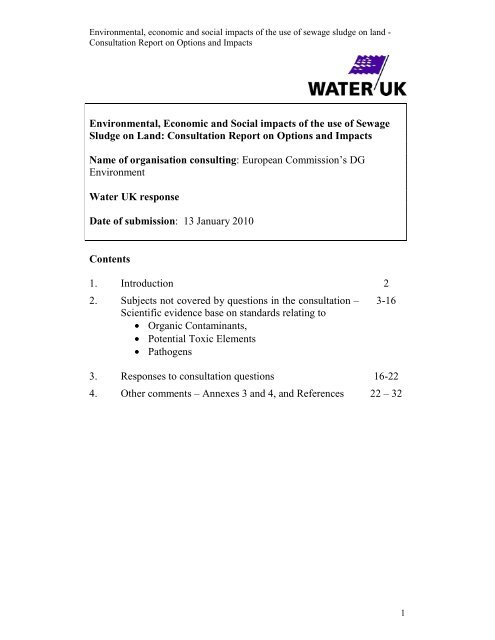

![Corporate social responsibility [CSR] has different ... - Water UK](https://img.yumpu.com/51398482/1/184x260/corporate-social-responsibility-csr-has-different-water-uk.jpg?quality=85)
